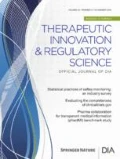Abstract
Safety assessment and monitoring are critical throughout the life cycle of drug development. The evaluation of safety information, specifically adverse events, from clinical trials has always been challenging for a number of reasons, such as the unexpectedness and rarity of some important adverse events, the fact that some events can recur, and the events’ variability in duration and severity. To accurately characterize and communicate the risk profile of a drug, the choice of metrics is critical. However, there seems to be a lack of consistency, clear guidance, and comprehensive recommendations on choosing metrics for assessing adverse events in clinical trials. This article reviews the common metrics and provides some recommendations.
Similar content being viewed by others
References
Management of Safety Information from Clinical Trials. Report of Council for International Organizations of Medical Sciences (CIOMS) Working Group VI. Geneva, Switzerland: World Health Organization; 2005.
Crowe B, Brueckner A, Beasley C, Kulkarni P. Current practices, challenges, and statistical issues with product safety labeling. Stat Biopharm Res. 2013;5(3):180–193.
Chuang-Stein C. Safety analysis in controlled clinical trials. Drug Inf J. 1998;32:1363–1372.
Siddiqui O. Statistical methods to analyze adverse events data of randomized clinical trials. J Biopharm Stat. 2009;19(5):889–899.
Black DM, Delmas PD, Eastell R, et al. Once-yearly zoledronic acid for treatment of postmenopausal osteoporosis. N Engl J Med. 2007;356:1809–1822.
Liu GF, Wang J, Liu K, Snavely DB. Confidence intervals for an exposure adjusted incidence rate difference with applications to clinical trials. Stat Med. 2006;25:1275–1286.
Bresalier RS, Sandler PS, Quan H, et al. Cardiovascular events associated with rofecoxib in a colorectal adenoma chemoprevention trial. N Engl J Med. 2005;352(11):1092–1102.
Rosenkranz G. Analysis of adverse events in the presence of discontinuations. Drug Inf J. 2006;40:79–87.
Heitjan DF. Ignorability and coarsening: some biomedical examples. Biometrics. 1993;49:1099–1109.
Lin DY, Robins JM, Wei LJ. Comparing two failure time distributions in the presence of dependent censoring. Biometrika. 1996;83:381–393.
Fine JP, Jiang H, Chappell R. On semi-competing risks data. Biometrika. 2001;88:907–919.
Jiang H, Chappell R, Fine JP. Estimating the distribution of nonterminal event time in the presence of mortality or informative dropout. Controlled Clin Trials. 2003;24:135–146.
Berkrot B. Biogen reports 10 more Tysabri PML cases, 4 deaths. Reuters, February 18, 2011. Available at: http://www.reuters.com/article/2011/02/18/biogen-tysabri-idUSN1811430320110218.
Xie T, et al. Statistical analysis of safety data in long-term clinical trials. Paper presented at the Joint Statistical Meetings—Biometrics Section; New York City, New York; 2002.
Menjoge SS. On estimation of frequency data with censored observations. Pharm Stat. 2003;2:191–197.
Nelson WB. Recurrent Events Analysis for Product Repairs, Disease Recurrences, and Other Applications. ASA-SIAM Series on Statistics and Applied Probability. Philadelphia, PA: Society for Industrial and Applied Mathematics; 2003.
Lin DY, Wei LJ, Yang I, Ying Z. Semiparametric regression for the mean and rate functions of recurrent events. J R Stat Soc B. 2000;62(4):711–730.
Laupacis A, Sackett DL, Roberts RS. An assessment of clinically useful measures of the consequences of treatment. N Engl J Med. 1988;318(26):1728–1733.
Mayne TJ, Whalen E, Vu A. Annualized was found better than absolute risk reduction in the calculation of number needed to treat in chronic conditions. J Clin Epidemiol. 2006;59:217–223.
Altman DG. Confidence intervals for the number needed to treat. BMJ. 1998;317(7168):1309–1312.
Kalbfleisch JD, Prentice RL. The Statistical Analysis of Failure Time Data. 2nd ed. New York, NY: John Wiley; 2002.
Dabrowska DM, Doksum KA, Song J. Graphical comparison of cumulative hazards for two populations. Biometrika. 1989;76:763–773.
Lin DY, Fleming T, Wei LJ. Confidence bands for survival curves under the proportional hazards model. Biometrika. 1994;81:73–82.
Parzen MI, Wei LJ, Ying Z. Simultaneous confidence intervals for the difference of two survival functions. Scand J Stat. 1997;24:309–314.
Greenland S. Additive risk versus additive relative risk models. Epidemiology. 1993;4:32–36.
Akobeng AK. Understanding measures of treatment effect in clinical trials. Arch Dis Child. 2005;90:54–56.
Citrome L. Relative vs. absolute measures of benefit and risk: what’s the difference? Acta Psychiatr Scand. 2010;121:94–102.
Guidance for industry, diabetes mellitus—evaluating cardiovascular risk in new antidiabetic therapies to treat type 2 diabetes. Silver Spring, MD: US Department of Health and Human Services, Food and Drug Administration; 2008.
Author information
Authors and Affiliations
Corresponding author
Rights and permissions
About this article
Cite this article
Zhou, Y., Ke, C., Jiang, Q. et al. Choosing Appropriate Metrics to Evaluate Adverse Events in Safety Evaluation. Ther Innov Regul Sci 49, 398–404 (2015). https://doi.org/10.1177/2168479014565470
Received:
Accepted:
Published:
Issue Date:
DOI: https://doi.org/10.1177/2168479014565470



